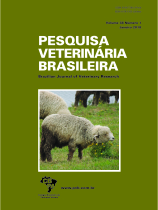 |
|
|
|
Year 2018 - Volume 38, Number 1
|

|
Blackleg in cattle in the state Mato Grosso do Sul, Brazil: 59 cases, 38(1):6-14
|
ABSTRACT.- Heckler R.F., Lemos R.A.A., Gomes D.C., Dutra I.S., Silva R.O.S., Lobato F.C.F., Ramos C.A.N. & Brumatti R.C. 2018. Blackleg in cattle in the state of Mato Grosso do Sul, Brazil: 59 cases. [Carbúnculo sintomático em bovinos em Mato Grosso do Sul: 59 casos.] Pesquisa Veterinária Brasileira 38(1):6-14. Laboratório de Anatomia Patológica, Faculdade de Medicina Veterinária e Zootecnia, Universidade do Federal do Mato Grosso do Sul, Av. Senador Filinto Müller 2443, Vila Ipiranga, Campo Grande, MS 79070-900, Brazil. E-mail: ricardo.lemos@ufms.br
This study aimed to review cases of blackleg (Clostridium chauvoei infection) diagnosed in cattle from Midwestern Brazil from 1994 to 2014 considering epidemiological, clinical, necropsy and histopathological findings. Also the following laboratory tests were used for the diagnosis of some cases of blackleg: microbiological culture and identification of the agent, microbiological culture and identification of the agent by the polymerase chain reaction (PCR), and identification of the agent in formalin fixed paraffin embedded tissues (FFPE). Criteria for presumptive diagnosis of blackleg included necrohemorrhagic emphysematous myositis consisting of inflammatory infiltrate, coagulative necrosis of myofiber, interstitial edema, hemorrhage, and gas bubbles between myofibers. Fifty nine cases from 51 outbreaks of blackleg were found, which corresponded to 1.1% of 5,375 cattle deaths investigated. In five of those outbreaks, samples of affected muscles cultures for the identification of pathogenic clostridia were made. Another three samples of similar material were cultured for clostridia with subsequent identification of the isolate by PCR. Twelve samples of FFPE affected muscle fragments were submitted to PCR for identification of the etiological agent. Except for January, cases were observed in each month of the year, with higher numbers in July-October. Most affected cattle were in the age of 7-12 years, but calves younger than 6 month-old and older than 24 months were also observed. Vaccination histories were scarce. In 32 outbreaks some vaccination history was available, but only in two of those vaccination has been carried out properly. In 56 six cases the skeletal muscles were involved. Muscles of the hind limbs were the most affected. In ten cases muscles of the tongue, myocardium and diaphragm were also affected. In three of the cases the visceral form was observed. Deaths occurred after a clinical course of 6-24 hours, but in most cases cattle were found death. Sudden death was the outcome in visceral cases (cardiac) blackleg. Clostridium chauvoei was confirmed to be the cause by culturing in 5 cases, and by PCR and histopatology in 8 cases. Bacterial culture followed by PCR did not demonstrate C. chauvoei. Calculation of the economic impact indicates that blackleg is a frequent disease in the state of Mato Grosso do Sul (MS) that inflicts significant economic loss. The amount of these losses would be reduced through proper vaccination programs against the prevalent strains of C. chauvoei in the region. |
| |
|
|
| |
|
 |